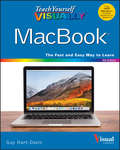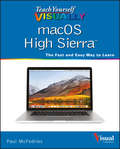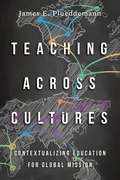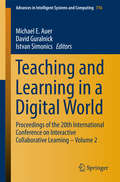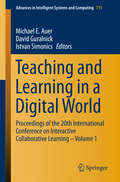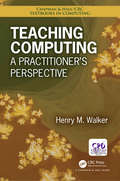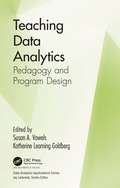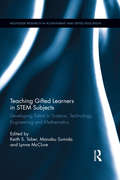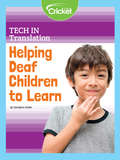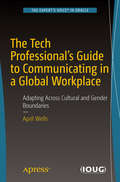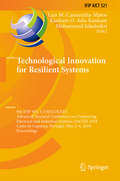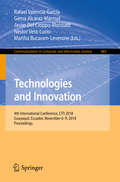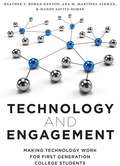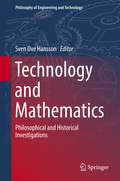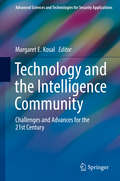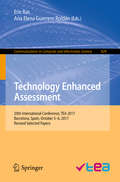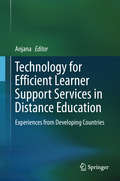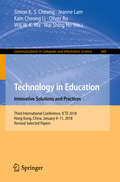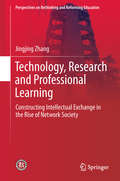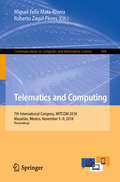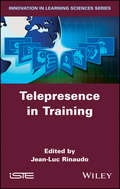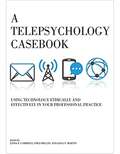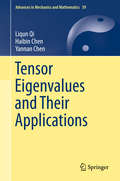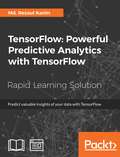- Table View
- List View
Teach Yourself VISUALLY MacBook (Teach Yourself VISUALLY (Tech))
by Guy Hart-DavisThe visual learner’s ultimate guide to the MacBook and macOS High Sierra Teach Yourself VISUALLY MacBook is your ultimate guide to getting up and running quickly with your new MacBook, MacBook Pro, or MacBook Air! Whether you’re new to computers or transitioning from a PC, this graphics-heavy guide will show you everything you need to know to get the most out of your new laptop. Clear, step-by-step instructions walk you through each task, with screenshots that help you follow along with confidence. You’ll learn how to manage files, work with macOS software, organize photos and media, set up email, access the internet, and adjust settings and preferences to make your MacBook work the way you work. You’ll also explore the features that bring computing to a whole new level, including iCloud, FaceTime, the App Store, and so much more! The Mac has long inspired a legion of loyal fans, and you’re about to find out why. From sleek design to intuitive interface, to an OS that just works, Apple has cornered the market on the high-end computing experience. The MacBook makes sublime computing portable, and this book shows you how to take advantage of all that your MacBook has to offer. Get acquainted with the latest macOS version and its new features Perform everyday tasks quickly and easily Customize preferences and settings to suit your needs Download new apps, video chat, save to the cloud, and much more! No confusing tech-speak, no vague instructions, and no complex tangents into obscure tasks. This friendly guide is packed with screenshots, easy-to-follow instructions, and a practical sensibility; you’re not launching the space shuttle, you just want to open your email. If you’re ready to explore all that your MacBook can do, Teach Yourself VISUALLY MacBook is your ideal companion.
Teach Yourself VISUALLY macOS High Sierra
by Paul McFedriesTake a guided tour of macOS High Sierra and discover just how much your Mac can do Teach Yourself VISUALLY macOS High Sierra is the perfect introduction to Apple's operating system. With clear, step-by-step instructions and plenty of rich visuals, it walks you through the new macOS High Sierra and demonstrates the essential tasks you need to know. You'll learn how to manipulate Preferences to customize your experience, make the most of your digital media, and streamline your workflow while having a little fun. You'll tour Photos, Messages, and Notifications, and get acquainted with Mission Control, the App Store, and Siri. New Mac users will appreciate the straightforward instruction, while veteran users will enjoy getting up to speed on the latest features introduced or upgraded in macOS High Sierra. macOS High Sierra is the latest incarnation of Apple's macOS, boasting elegant new visuals, several new features, and more seamless integration of Mac and iOS devices. If you use a Mac, you're going to want a guided tour that shows you just what macOS can do for you. Teach Yourself VISUALLY macOS High Sierra is your go-to guide, from the fundamentals to the neat little tricks that make the Mac experience something far beyond computing. • Edit and enhance photos with the powerful new tools on the Photos app • Browse the web safely with Safari's new privacy features • Share files quickly and easily using iCloud Drive • Use Siri to accomplish more in less time Like any computer, your Mac is a tool. And like any tool, the more you know about it, the more you get out of it. Discover the beauty, simplicity, and sheer functionality that millions already enjoy—and get ready to master your Mac with Teach Yourself VISUALLY macOS High Sierra.
Teaching Across Cultures: Contextualizing Education for Global Mission
by James E. PlueddemannIn our globalized world, educators often struggle to adapt to the contexts of diverse learners. In this practical resource, educator and missiologist James Plueddemann offers field-tested insights for teaching across cultural differences. He unpacks how different cultural dynamics may inhibit learning and offers a framework for integrating conceptual ideas into practical experience.
Teaching and Learning in a Digital World
by Michael E. Auer David Guralnick Istvan SimonicsThis book gathers the Proceedings of the 20th International Conference on Interactive Collaborative Learning (ICL2017), held in Budapest, Hungary on 27–29 September 2017. The authors are currently witnessing a significant transformation in the development of education. The impact of globalisation on all areas of human life, the exponential acceleration of technological developments and global markets, and the need for flexibility and agility are essential and challenging elements of this process that have to be tackled in general, but especially in engineering education.To face these current real-world challenges, higher education has to find innovative ways to quickly respond to them. Since its inception in 1998, this conference has been devoted to new approaches in learning with a focus on collaborative learning. Today the ICL conferences offer a forum for exchange concerning relevant trends and research results, and for sharing practical experience gained while developing and testing elements of new technologies and pedagogies in the learning context.
Teaching and Learning in a Digital World: Proceedings Of The 20th International Conference On Interactive Collaborative Learning - Volume 1 (Advances In Intelligent Systems And Computing #715)
by Michael E. Auer David Guralnick Istvan SimonicsThis book gathers the Proceedings of the 20th International Conference on Interactive Collaborative Learning (ICL2017), held in Budapest, Hungary on 27-29 September 2017. The authors are currently witnessing a significant transformation in the development of education. The impact of globalisation on all areas of human life, the exponential acceleration of technological developments and global markets, and the need for flexibility and agility are essential and challenging elements of this process that have to be tackled in general, but especially in engineering education. To face these current real-world challenges, higher education has to find innovative ways to quickly respond to them. Since its inception in 1998, this conference has been devoted to new approaches in learning with a focus on collaborative learning. Today the ICL conferences offer a forum for exchange concerning relevant trends and research results, and for sharing practical experience gained while developing and testing elements of new technologies and pedagogies in the learning context.
Teaching Computing: A Practitioner's Perspective
by Henry M. WalkerTeaching can be intimidating for beginning faculty. Some graduate schools and some computing faculty provide guidance and mentoring, but many do not. Often, a new faculty member is assigned to teach a course, with little guidance, input, or feedback. Teaching Computing: A Practitioner’s Perspective addresses such challenges by providing a solid resource for both new and experienced computing faculty. The book serves as a practical, easy-to-use resource, covering a wide range of topics in a collection of focused down-to-earth chapters. Based on the authors’ extensive teaching experience and his teaching-oriented columns that span 20 years, and informed by computing-education research, the book provides numerous elements that are designed to connect with teaching practitioners, including: A wide range of teaching topics and basic elements of teaching, including tips and techniques Practical tone; the book serves as a down-to-earth practitioners’ guide Short, focused chapters Coherent and convenient organization Mix of general educational perspectives and computing-specific elements Connections between teaching in general and teaching computing Both historical and contemporary perspectives This book presents practical approaches, tips, and techniques that provide a strong starting place for new computing faculty and perspectives for reflection by seasoned faculty wishing to freshen their own teaching.
Teaching Data Analytics: Pedagogy and Program Design (Data Analytics Applications)
by Susan A Vowels Katherine Leaming GoldbergThe need for analytics skills is a source of the burgeoning growth in the number of analytics and decision science programs in higher education developed to feed the need for capable employees in this area. The very size and continuing growth of this need means that there is still space for new program development. Schools wishing to pursue business analytics programs intentionally assess the maturity level of their programs and take steps to close the gap. Teaching Data Analytics: Pedagogy and Program Design is a reference for faculty and administrators seeking direction about adding or enhancing analytics offerings at their institutions. It provides guidance by examining best practices from the perspectives of faculty and practitioners. By emphasizing the connection of data analytics to organizational success, it reviews the position of analytics and decision science programs in higher education, and to review the critical connection between this area of study and career opportunities. The book features: A variety of perspectives ranging from the scholarly theoretical to the practitioner applied An in-depth look into a wide breadth of skills from closely technology-focused to robustly soft human connection skills Resources for existing faculty to acquire and maintain additional analytics-relevant skills that can enrich their current course offerings. Acknowledging the dichotomy between data analytics and data science, this book emphasizes data analytics rather than data science, although the book does touch upon the data science realm. Starting with industry perspectives, the book covers the applied world of data analytics, covering necessary skills and applications, as well as developing compelling visualizations. It then dives into pedagogical and program design approaches in data analytics education and concludes with ideas for program design tactics. This reference is a launching point for discussions about how to connect industry’s need for skilled data analysts to higher education’s need to design a rigorous curriculum that promotes student critical thinking, communication, and ethical skills. It also provides insight into adding new elements to existing data analytics courses and for taking the next step in adding data analytics offerings, whether it be incorporating additional analytics assignments into existing courses, offering one course designed for undergraduates, or an integrated program designed for graduate students.
Teaching Gifted Learners in STEM Subjects: Developing Talent in Science, Technology, Engineering and Mathematics (Routledge Research in Achievement and Gifted Education)
by Keith S. Taber Manabu Sumida Lynne McClureThis book offers an overview of programmes designed to support the learning of gifted and talented students in STEM subjects, both to allow them to meet their potential and to encourage them to proceed towards careers in STEM areas. The chapters from a range of national contexts report on perspectives, approaches and projects in gifted education in STEM subjects. These contributions provide a picture of the state of research and practice in this area, both to inform further research and development, and to support classroom teachers in their day-to-day work. Chapters have been written with practitioners in mind, but include relevant scholarly citations to the literature. The book includes some contributions illustrating research and practice in specific STEM areas, and others which bridge across different STEM subjects. The volume also includes an introductory theoretical chapter exploring the implications for gifted learners of how 'STEM' is understood and organized within the school curriculums.
Tech in Translation
by Carollyne HutterIn Morocco, deaf children were at a disadvantage when it comes to their education. When Dr. Abdelhadi Soudi built a computer program that can translate sign language, it improved the way Morocco teaches their deaf children by leaps and bounds!
The Tech Professional's Guide to Communicating in a Global Workplace: Adapting Across Cultural And Gender Boundaries
by April WellsInformation technologists are increasingly being made part of global teams, and are confronting the challenges of communicating across a variety of linguistic and cultural boundaries. This book helps you know what to say, what not to say, and even where to sit in meetings and in social situations.The Tech Professional's Guide to Communicating in a Global Workplace shows you how to effectively communicate across a variety of different cultures within and across organizations. You will become aware of cultural differences from one country or region to another, between various groups at the local level, and across groups such as developers to DBAs, IT staff to business people, women to men, people approaching retirement to people coming into the organization fresh out of college, and more. The author provides her personal experiences and shares anecdotes as well as lessons learned, key takeaways, and references for further reading. Whether it is face to face, over the phone, via email or instant messenger, or in a presentation, meeting, or report, the ability to communicate effectively is critical.What You'll LearnConcisely communicate with the right audience in the right wayWrite emails that are understood and get the results you wantImprove personal reputation as an effective communicatorCommunicate across cultural boundaries without offendingPresent the desired impression in business situationsGrow professionally by adjusting your communication styleWho This Book Is ForProgrammers and system administrators, including database administrators
Technological Innovation for Resilient Systems: 9th Ifip Wg 5. 5/socolnet Advanced Doctoral Conference On Computing, Electrical And Industrial Systems, Doceis 2018, Costa De Caparica, Portugal, May 2-4, 2018, Proceedings (IFIP Advances in Information and Communication Technology #521)
by Luis M. Camarinha-Matos Kankam O. Adu-Kankam Mohammad JulashokriThis book constitutes the refereed proceedings of the 9th IFIP WG 5.5/SOCOLNET Advanced Doctoral Conference on Computing, Electrical and Industrial Systems, DoCEIS 2018, held in Costa de Caparica, Portugal, in May 2018. The 30 revised full papers presented were carefully reviewed and selected from 74 submissions. The papers present selected results produced in engineering doctoral programs and focus on technological innovation for resilient systems. Research results and ongoing work are presented, illustrated and discussed in the following areas: collaborative systems, decision support systems, supervision systems, energy management, smart grids, sensing systems, electrical systems, simulation and analysis, monitoring systems, and energy distribution systems.
Technologies and Innovation: 4th International Conference, CITI 2018, Guayaquil, Ecuador, November 6-9, 2018, Proceedings (Communications in Computer and Information Science #883)
by Rafael Valencia-García Gema Alcaraz-Mármol Javier Del Cioppo-Morstadt Néstor Vera-Lucio Martha Bucaram-LeveroneThis book constitutes the proceedings of the 4th International Conference on Technologies and Innovation, CITI 2018, held in Guayaquil, Ecuador, in November 2018. The 21 full papers presented in this volume were carefully reviewed and selected from 64 submissions. They are organized in topical sections named: ICT in agronomy; software engineering; intelligent and knowledge-based systems; e-learning.
Technology and Engagement: Making Technology Work for First Generation College Students
by Heather T. Rowan-Kenyon Ana M. Martínez Alemán Mandy Savitz-RomerTechnology and Engagement is based on a four-year study of how first generation college students use social media, aimed at improving their transition to and engagement with their university. Through web technology, including social media sites, students were better able to maintain close ties with family and friends from home, as well as engage more with social and academic programs at their university. This ‘ecology of transition’ was important in keeping the students focused on why they were in college, and helped them become more integrated into the university setting. By showing the gains in campus capital these first-generation college students obtained through social media, the authors offer concrete suggestions for how other universities and college-retention programs can utilize the findings to increase their own retention of first-generation college students.
Technology and Mathematics: Philosophical and Historical Investigations (Philosophy of Engineering and Technology #30)
by Sven Ove HanssonThis volume is the first extensive study of the historical and philosophical connections between technology and mathematics. Coverage includes the use of mathematics in ancient as well as modern technology, devices and machines for computation, cryptology, mathematics in technological education, the epistemology of computer-mediated proofs, and the relationship between technological and mathematical computability. The book also examines the work of such historical figures as Gottfried Wilhelm Leibniz, Charles Babbage, Ada Lovelace, and Alan Turing.
Technology and the Intelligence Community: Challenges And Advances For The 21st Century (Advanced Sciences and Technologies for Security Applications)
by Margaret E. KosalThis volume examines the role of technology in gathering, assimilating and utilizing intelligence information through the ages. Pushing the boundaries of existing works, the articles contained here take a broad view of the use and implementation of technology and intelligence procedures during the cold war era and the space race, the September 2011 attacks, and more recent cyber operations. It looks at the development of different technologies, procedural implications thereof, and the underlying legal and ethical implications. The findings are then used to explore the future trends in technology including cyber operations, big data, open source intelligence, smart cities, and augmented reality. Starting from the core aspects of technical capabilities the articles dig deeper, exploring the hard and soft infrastructure of intelligence gathering procedures and focusing on the human and bureaucratic procedures involved therein.Technology and innovation have played an important role in determining the course of development of the intelligence community. Intelligence gathering for national security, however, is not limited only to the thread of technical capabilities but is a complex fabric of organizational structures, systemic undercurrents, and the role of personnel in key positions of decision making. The book’s findings and conclusions encompass not just temporal variation but also cut across a diverse set of issue areas. This compilation is uniquely placed in the interdisciplinary space combining the lessons from key cases in the past to current developments and implementation of technology options.
Technology Enhanced Assessment: 20th International Conference, Tea 2017, October 5-6, 2017, Barcelona, Spain (Communications In Computer And Information Science #829)
by Eric Ras Ana Elena Guerrero RoldánThis book constitutes the proceedings of the 20th International Conference on Technology Enhanced Assessment, TEA 2017, held in Barcelona, Spain, in October 2017. The 17 papers presented were carefully selected from 42 submissions. They are centered around topics like e-learning, computer-assisted instruction, interactive learning environments, collaborative learning, computing education, student assessment.Chapter "Student perception of scalable peer-feedback design in Massive Open Online Courses" is licensed under the terms of the Creative Commons Attribution 4.0 International License (http://creativecommons.org/licenses/by/4.0/). For further details see license information in the chapter.
Technology for Efficient Learner Support Services in Distance Education: Experiences from Developing Countries
by AnjanaThis book explores the ways in which technology is being used by various open universities in developing countries to extend learner support services to distance learners. It shares the best practices being followed by different open universities so that these may be replicated by other universities. It provides an overview of the use of various digital technologies, e-learning tools, eLearning platforms, virtual learning environments, and synchronous and asynchronous technologies in open and distance learning (ODL) systems. Moreover, it discusses the importance of ODL systems in providing inclusive education in developing countries through the use of ICT with a special focus on adult, rural and elderly learners, as well as the role of technology in science education through ODL system. A transformative model of sustainable collaborative learning is presented, integrating concepts based on theoretical frameworks to increase the flexibility and solve existing issues in developing countries, which may be used for policy changes in distance learning. It concludes by examining various challenges in successfully implementing technology for effective delivery of learner support services in distance education systems in developing countries and exploring the strategies required to overcome these challenges.
Technology in Education. Innovative Solutions and Practices: Third International Conference, ICTE 2018, Hong Kong, China, January 9-11, 2018, Revised Selected Papers (Communications in Computer and Information Science #843)
by Wai Shing Ho Will W.K. Ma Oliver Au Kam Cheong Li Jeanne Lam Simon K.S. CheungThis book constitutes extended papers from the Third International Conference on Technology in Education, ICTE 2018, held in Hong Kong, China, in January 2018.The 27 full papers presented in this volume were carefully reviewed and selected from 88 submissions. They are organized in topical sections on new learning experience with technologies; mobile learning and flipped classrooms; instructional design and teaching practices; learning administration with technologies.
Technology, Research and Professional Learning: Constructing Intellectual Exchange in the Rise of Network Society (Perspectives on Rethinking and Reforming Education)
by Jingjing ZhangThis book investigates the use of network technologies in research, and explores how such use potentially changes the nature of professional learning between academics. It attempts to situate the discussion of technology use in real-world research settings, to identify the different forms of participation in intellectual exchange embedded in academic dialogue, and to further contribute to knowledge on how the use of network technology potentially changes the nature of learning. Multiple data collection methods are employed, in two forms of study: a single case study, and a number of individual interviews. The single case study was carried out over a one-year period, and consisted of interviews (22 interviewees), observations, and document review. Individual semi-structured interviews were carried out over a similar period of time with a wider and different population of 24 academics from different Oxford faculties. Half of these were interviewed twice.The main findings presented in this book demonstrate that the direct consequences of technology use are changes to academic dialogue and scholarly communication in general. The change to this critical aspect of research – scholarly communication – has potentially led to more distributed research in interconnected research environments. It is the changes to scholarly communication and the research environment that consequently affect participation in intellectual exchange.
Telematics and Computing: 7th International Congress, WITCOM 2018, Mazatlán, Mexico, November 5-9, 2018, Proceedings (Communications in Computer and Information Science #944)
by Miguel Felix Mata-Rivera Roberto Zagal-FloresThis book constitutes the thoroughly refereed proceedings of the 7th International Congress on Telematics and Computing, WITCOM 2018, held in Mazatlán, Mexico in November 2018.The 23 full papers presented in this volume were carefully reviewed and selected from 57 submissions. They present and organize the knowledge from within the field of telematics and security, data analytics and Machine Learning, IoT and mobile computing.
Telepresence in Training
by Jean-Luc RinaudoThe different forms of telepresence in education, in distance learning, in student support, in the use of learning environments or even at the heart of robot systems, are developed in universities and higher education facilities specializing in professional training. They constitute opportunities to reform arguments and give rise to important questions: how should we think about the hierarchy of presence and absence in these techniques in order to make possible “the presence of the absent”? What is the effect on mediation processes? On the perception of the body and on identity? How does it transform collaborative work? Telepresence in Training brings together research that attempts to answer these questions by using studies and practical supports from higher education, with regards to teacher training and telepresence robots in France, Belgium, Switzerland and Quebec.
A Telepsychology Casebook: Using Technology Ethically and Effectively in Your Professional Practice
by Linda F. CampbellThis casebook provides practical recommendations on a range of issues associated with electronic-based mental health care. <p><p>From technologies as simple as the telephone to more advanced webcams and mobile device applications, psychologists are increasingly using technology in their work—a practice known as telepsychology. Telepsychology allows clinicians to conduct remote therapy sessions, supplement in-person sessions with resources and follow-up care, collect and store client data, and more. <p><p>The book's recommendations draw from the Guidelines for the Practice of Telepsychology, which were created jointly by APA, the Association of State and Provincial Psychology Boards, and the American Insurance Trust. Each chapter presents a guideline, explains how it relates to professional ethics and standards of care, and applies it to case examples. The richly nuanced case examples depict a broad range of dilemmas that psychologists may encounter when conducing telepsychology, as well as a broad range of settings, including hospitals, community health centers, private practice, industrial/organizational settings, forensic settings, academia, military, and veterans' centers. Whatever setting you practice in, you will find guidance for applying technology effectively, legally, and ethically.
Ten Arguments for Deleting Your Social Media Accounts Right Now
by Jaron LanierA timely call-to-arms from a Silicon Valley pioneer. <p><p>You might have trouble imagining life without your social media accounts, but virtual reality pioneer Jaron Lanier insists that we’re better off without them. In Ten Arguments for Deleting Your Social Media Accounts Right Now, Lanier, who participates in no social media, offers powerful and personal reasons for all of us to leave these dangerous online platforms. <p>Lanier’s reasons for freeing ourselves from social media’s poisonous grip include its tendency to bring out the worst in us, to make politics terrifying, to trick us with illusions of popularity and success, to twist our relationship with the truth, to disconnect us from other people even as we are more “connected” than ever, to rob us of our free will with relentless targeted ads. <p> How can we remain autonomous in a world where we are under continual surveillance and are constantly being prodded by algorithms run by some of the richest corporations in history that have no way of making money other than being paid to manipulate our behavior? How could the benefits of social media possibly outweigh the catastrophic losses to our personal dignity, happiness, and freedom? <p>Lanier remains a tech optimist, so while demonstrating the evil that rules social media business models today, he also envisions a humanistic setting for social networking that can direct us toward a richer and fuller way of living and connecting with our world.
Tensor Eigenvalues and Their Applications (Advances in Mechanics and Mathematics #39)
by Liqun Qi Haibin Chen Yannan ChenThis book offers an introduction to applications prompted by tensor analysis, especially by the spectral tensor theory developed in recent years. It covers applications of tensor eigenvalues in multilinear systems, exponential data fitting, tensor complementarity problems, and tensor eigenvalue complementarity problems. It also addresses higher-order diffusion tensor imaging, third-order symmetric and traceless tensors in liquid crystals, piezoelectric tensors, strong ellipticity for elasticity tensors, and higher-order tensors in quantum physics. This book is a valuable reference resource for researchers and graduate students who are interested in applications of tensor eigenvalues.
TensorFlow: Predict valuable insights of your data with TensorFlow
by Md. Rezaul KarimLearn how to solve real life problems using different methods like logic regression, random forests and SVM’s with TensorFlow.Key FeaturesUnderstand predictive analytics along with its challenges and best practices Embedded with assessments that will help you revise the concepts you have learned in this bookBook DescriptionPredictive analytics discovers hidden patterns from structured and unstructured data for automated decision making in business intelligence. Predictive decisions are becoming a huge trend worldwide, catering to wide industry sectors by predicting which decisions are more likely to give maximum results. TensorFlow, Google’s brainchild, is immensely popular and extensively used for predictive analysis.This book is a quick learning guide on all the three types of machine learning, that is, supervised, unsupervised, and reinforcement learning with TensorFlow. This book will teach you predictive analytics for high-dimensional and sequence data. In particular, you will learn the linear regression model for regression analysis. You will also learn how to use regression for predicting continuous values. You will learn supervised learning algorithms for predictive analytics. You will explore unsupervised learning and clustering using K-meansYou will then learn how to predict neighborhoods using K-means, and then, see another example of clustering audio clips based on their audio features. This book is ideal for developers, data analysts, machine learning practitioners, and deep learning enthusiasts who want to build powerful, robust, and accurate predictive models with the power of TensorFlow. This book is embedded with useful assessments that will help you revise the concepts you have learned in this book.What you will learnLearn TensorFlow features in a real-life problem, followed by detailed TensorFlow installation and configurationExplore computation graphs, data, and programming models also get an insight into an example of implementing linear regression model for predictive analyticsSolve the Titanic survival problem using logistic regression, random forests, and SVMs for predictive analyticsDig deeper into predictive analytics and find out how to take advantage of it to cluster records belonging to the certain group or class for a dataset of unsupervised observationsLearn several examples of how to apply reinforcement learning algorithms for developing predictive models on real-life datasetsWho this book is forThis book is aimed at developers, data analysts, machine learning practitioners, and deep learning enthusiasts who want to build powerful, robust, and accurate predictive models with the power of TensorFlow.
